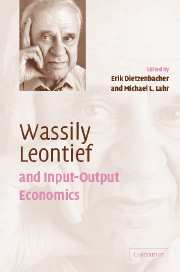Book contents
- Frontmatter
- Contents
- List of contributors
- List of figures
- List of tables
- Preface
- Part I Reflections on input-output economics
- Part II Perspectives of input-output economics
- 10 A neoclassical analysis of total factor productivity using input-output prices
- 11 What has happened to the Leontief Paradox?
- 12 The decline in labor compensation's share of GDP: a structural decomposition analysis for the United States, 1982 to 1997
- 13 An oligopoly model in a Leontief framework
- 14 Economies of plant scale and structural change
- 15 Technological change and accumulated capital: a dynamic decomposition of Japan's growth
- 16 Japan's economic growth and policy-making in the context of input-output models
- 17 Contributions of input-output analysis to the understanding of technological change: the information sector in the United States
- 18 How much can investment change trade patterns? An application of dynamic input-output models linked by international trade to an Italian policy question
- 19 Social cost in the Leontief environmental model: rules and limits to policy
- Subject index
- Author index
14 - Economies of plant scale and structural change
Published online by Cambridge University Press: 22 September 2009
- Frontmatter
- Contents
- List of contributors
- List of figures
- List of tables
- Preface
- Part I Reflections on input-output economics
- Part II Perspectives of input-output economics
- 10 A neoclassical analysis of total factor productivity using input-output prices
- 11 What has happened to the Leontief Paradox?
- 12 The decline in labor compensation's share of GDP: a structural decomposition analysis for the United States, 1982 to 1997
- 13 An oligopoly model in a Leontief framework
- 14 Economies of plant scale and structural change
- 15 Technological change and accumulated capital: a dynamic decomposition of Japan's growth
- 16 Japan's economic growth and policy-making in the context of input-output models
- 17 Contributions of input-output analysis to the understanding of technological change: the information sector in the United States
- 18 How much can investment change trade patterns? An application of dynamic input-output models linked by international trade to an Italian policy question
- 19 Social cost in the Leontief environmental model: rules and limits to policy
- Subject index
- Author index
Summary
Introduction
This paper has two objectives. The first is to examine the effectiveness and usefulness of the establishment base production function for analyzing production structure. The second is to investigate how the expansion of plant capacity affects structural change, based on the parameter estimates of production functions.
The process of economic development is characterized by structural change. Sustained economic growth can be achieved only via a select subset of potential paths for structural change. We hope to illuminate at least one path that has led to sustained economic growth by analyzing rigorously the development process of the post-war Japanese economy.
By structural change we mean technological change (see Leontief et al., 1953; Carter, 1970). We use these terms interchangeably and adopt the normal input-output definition of technological change as changes in capital coefficients and intermediate input coefficients. In our model, changes in capital coefficients depend upon the magnitude of plant capacity. In a large subset of industries, changes in plant capacity are determined endogenously through the unit cost minimization behavior of corporations.
This endogeneity of changes in capital coefficients derives from our production function parameter estimates. Rather than assuming the standard homogeneous production function, we specify a function that allows limited substitutability among factors of production. We call this a non-homothetic, factor-limited production function; see, e.g., Komiya (1962), Komiya and Uchida (1963), Lau and Tamura (1972) and Nakamura (1990). Its specification and estimation are another contribution of this paper.
- Type
- Chapter
- Information
- Wassily Leontief and Input-Output Economics , pp. 232 - 255Publisher: Cambridge University PressPrint publication year: 2004
- 1
- Cited by



